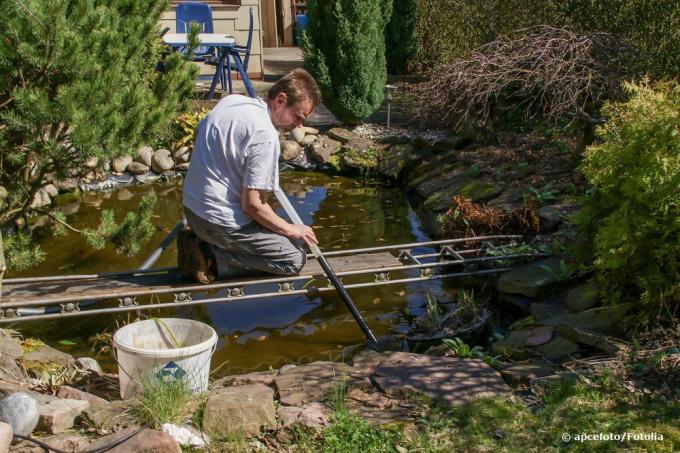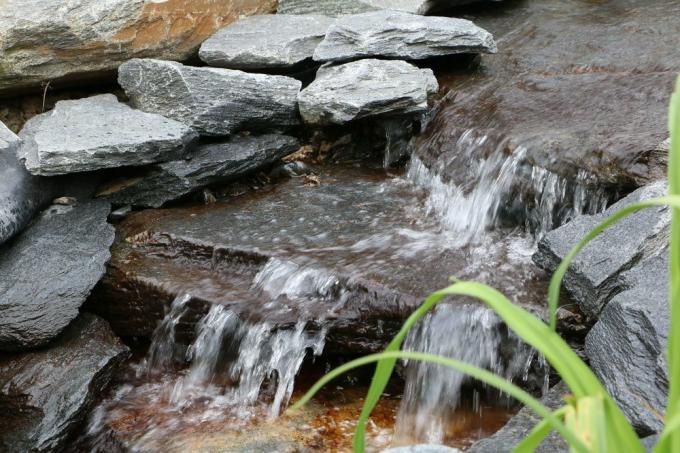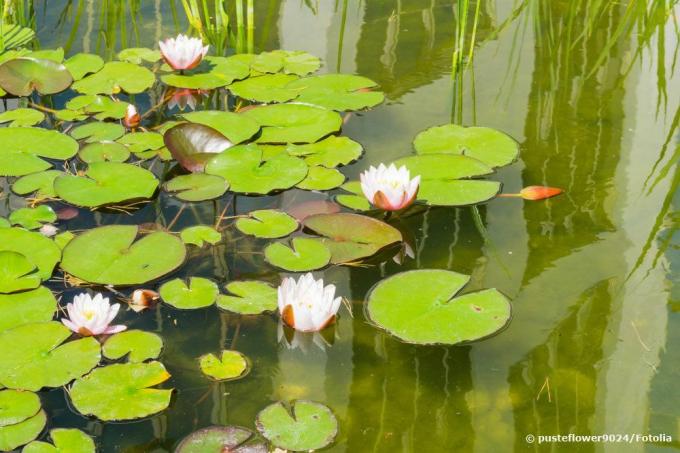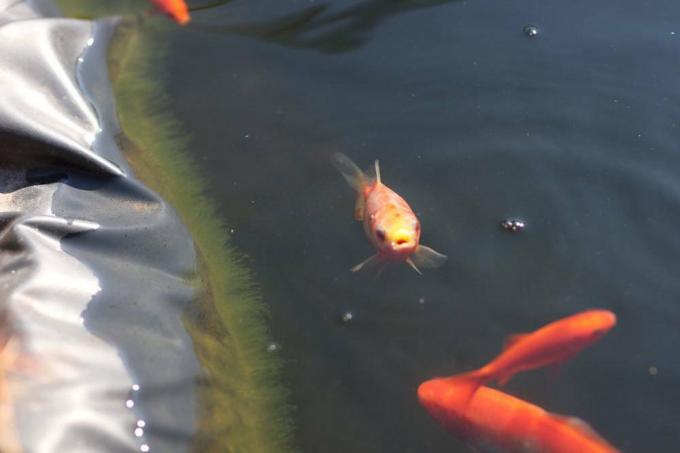
table of contents
- Floating algae
- causes
- Why remove algae?
- Remove algae
- UV-C water clarifier
- Pond sludge sucker and skimmer
- Water depth and light conditions
- Water movement
- Pond plants
- Fish and other aquatic animals
- Pond cleaning
- Mineral binders
- Algaecides - algae killers
- Prevent algae formation
Different types of algae can be found in each pond. They are essential for life, serve to nourish microorganisms such as water fleas and, due to their photosynthesis, are an important supplier of oxygen in the water. Occurring in moderation with a normal concentration of nutrients in the pond, there is no need to worry. However, if they occur in abundance, it is a sure sign that the pond's balance is out of joint. Then quick action is the order of the day.
Floating algae
Colloquially, this type of algae is also called Green algae designated. They are microscopic and float freely on the water surface as a green visible veil. Floating algae develop explosively, especially in spring, when the supply of nutrients in the pond is still very high because the aquatic plants and other microorganisms are not yet active. This process is also known as algal bloom. This is indicated by
- cloudy and green water
- a depth of view of only a few centimeters
tip: It is normal for the water to be slightly cloudy, even in natural waters. A depth of view of around one meter is sufficient.
During the algae bloom, organic material is formed from the algae, or they die and sink to the bottom. There it begins to one Sludge layer to rot, however, deprives the water of oxygen. This layer of sludge in turn forms the basis for new algae growth.
causes
However, excessive algae growth is not always a sign of an ecological imbalance in the pond. Algae growth can be observed especially in newly created ponds or when the water is changed. However, it subsides after a week or two. Normally, floating algae in a pond are of no concern in low concentrations. However, these can multiply quickly under suitable conditions.
- Increase in water temperature
- Sun exposure in spring and summer
- high nutrient content of the water
- increased phosphate content
Phosphate is the basic nutrient for algae. Floating algae therefore find very good conditions for rapid reproduction in ponds with a high phosphate content. Even a concentration of phosphate above 0.035 milligrams per liter can lead to algal blooms.
An excessive phosphate content in the water can have various causes:
- Rinsing in nutrients from the environment through rain (lawn fertilizer, nutrient-rich soil)
- Excess fish feed and fish droppings on the pond floor
- dead algae
Why remove algae?
In principle, algae are useful plants in the pond. They remove nutrients from the water and provide oxygen in return. Normally no other plant or technique is as effective as floating algae.
- every second oxygen molecule comes from algae
- convert three times as much carbon dioxide into oxygen than any other crop
On the other hand, algae also remove as much oxygen from the water at night as they produce during the day. Due to the large number of floating algae in the pond, there are strong oxygen fluctuations between day and night. A deficiency can very quickly become a threat to aquatic plants and fishes will. Further side effects of an excessive algae population are, for example
- a lower one KH value of the water (carbonate hardness) and
- an increased pH
In addition, it should be noted that dead algae on the ground release nutrients with the help of oxygen during their decay process. The resulting sludge layer forms the basis for renewed algae formation. If nothing is done, the pond threatens to silt up over time.
tip: Usually a little patience is required when an algae blooms. As a rule, the reproduction cycle is interrupted by the algae themselves after two to three weeks.
If this is not the case, however, then action must be taken.
Remove algae
Now there are different methods to banish algae from the garden pond. The specialist trade offers various means. However, it should be borne in mind that in some cases only the symptoms are combated and not the causes. This will clear the water, but the algae will continue to grow. Quick action is necessary, especially when algae appear more frequently. Sometimes pond filters are no longer sufficient here because the algae cannot be absorbed by the filter due to their size. There are other solutions for this:
UV-C water clarifier
A permanent solution to algae control is the use of a UV-C water clarifier in the pond. However, this UV-C lamp only lasts for one pond season at a time. It should therefore be renewed every spring. The function of this device is relatively simple:
- Pond pump directs water through UV-C water clarifier
- then reaches the mechanical filter
- Ultraviolet light destroys the genetic information of the algae there
- Algae clump together
- Filter removes residues
- UV radiation is harmless for the pond and residents
- UV-C lamp already integrated in many pond filters
- if not, easy integration into the water cycle is possible
- Important installation in front of the filter, otherwise the algae residues will not be absorbed
Pond sludge sucker and skimmer
Both devices are reliable helpers in pond maintenance.
- Vacuum cleaner removes nutrient-rich debris from the floor
- Skimmer removes floating foreign matter
- Water is sucked into the pond surface and fed to the filter

Water depth and light conditions
A lot of sunlight accelerates the growth of algae, so a garden pond should be at least a third in the shade. The amount and depth of water also have a direct influence on the development of algae. Have so small, shallow ponds to deal with algae problems much more often than larger plants. The use of different plants for shading can be helpful:
- Plants with large floating leaves (water lily, lotus, sea can, frog bite)
- Plants under the surface of the water with a simultaneous cleaning effect such as water hose and water weed
- for riparian zone water rush, Purple loosestrife, Cattail, arrowhead, iris
- not too much when planted nutrient-rich soil bring into pond
- Use of special aquatic plant soil
tip: Carry out regular checks of the pond water with the pond test set. The ideal GH value (hardness of water) should be between 8 and 12 dH.
Water movement
It is generally known that constant water movement is not exactly conducive to the development of algae. It is therefore advisable to think about alternatives such as
- Installation of fountains or watercourses
- simply place a sturdy oak branch in the water
- thereby lowering the pH value by releasing tannic acid
- poor living conditions for algae
- Remove the branch before it decomposes, otherwise the process is reversed
Pond plants
Aquatic plants are a kind of biological filter. Vigorously growing plants remove nutrients from the water. The more plants there are in a pond, the less food there is for the algae. They should therefore not be missing in any pond.
- Aquatic plants are the main food competitor for algae
- Cover about a third of the water surface with plants
- particularly suitable hornwort, milfoil, waterweed, frog bite, crab claw, duckweed
- Thinning plants from time to time due to strong growth
- Clippings can be put on compost
- Regular fishing of the algae using a special algae net
- Algae are easily compostable
- ideally, equilibrium is achieved in the pond
Fish and other aquatic animals
Fish and other small aquatic creatures also function like a biological filter.
However, it should always be ensured that the number of animals is limited. If possible, they should be drawn from the natural sources of food in the pond (e.g. Algae). An additional feed of fish food would in turn increase the nutrient content of the pond.
- for larger ponds grass carp, silver carp or koi carp
- Caution: also eat smaller fish and soft pond and underwater plants
- rudd for smaller ponds, Goldfish
- also use of water fleas, European freshwater shrimp and Pond clams
- Snails also eat algae (pond snail, ramshorn snail, pointed mud snail, small mud snail)
- By mid-May, water fleas had already eaten up all the cloudy water
- In addition, in fish ponds, a filter system is necessary to dispose of excess nutrients
- add additional technology, especially for large fish
- do not use animals from local waters (nature conservation)
Pond cleaning
The most effective way of combating algae in the garden pond is without a doubt a complete cleaning of the small body of water. However, a few things should be taken into account:
- not just exchange water
- clean all utensils thoroughly
- Remove sludge from the pond floor
- Replace old pond soil with new, nutrient-poor substrate
- Use of nutrient-poor sand (as little as possible)
- Cut back the plants vigorously and divide them if necessary
- Put in new nutrient-poor pond soil and special plant baskets or embankment mats
- specially tested tap water suitable for filling
- sometimes tap water enriched with up to 5 milligrams of phosphate per liter (protection of pipes against corrosion)
- if they contain a lot of phosphate, use of phosphate binders
- better suited groundwater, is low in phosphate
- however, rainwater would be optimal
tip: Smaller ponds can be covered with small nets in autumn. This prevents leaves from getting into the water.
Mineral binders
These remedies offered by specialist retailers eliminate the symptoms, but not the cause. Flocculants for quick clarification of the water are very popular here
Phosphate binder:
- is not absorbed by algae or other aquatic plants
- Phosphate bound by chemical processes
- So algae deprived of their nutritional basis
- various means available
- either sprinkle the agent directly into the pond water
- insert others directly into filters
- harmless to fish
Algaecides - algae killers
Here, too, various products are available from specialist retailers. Although the use of these agents leads to the clarification of the water quickly, the causes are not eliminated. However, if used continuously and in the wrong dosage, these agents are harmful to fish and other microorganisms.
- sometimes the algae clump together
- Then take up through the filter
- other agents contain monolinron or copper sulfate
- Use only with precise knowledge of the pond volume due to correct dosage
- do not use permanently
- if the water values do not match the recommended values - medium ineffective
tip: It is recommended to measure the depth of view in the pond. This gives information about the success of the algae control. To do this, dip a folding rule so deep into the water that the point can no longer be seen.
Prevent algae formation
When creating a new garden pond, a lot can be done to prevent algae from spreading en masse in the pond. A few factors must be taken into account:
- choose the right location
- Unsuitable pond in a depression
- Mineral fertilizers and garden soil from the surrounding area can get into the pond
- better place on a slight hill
- not directly under trees (leaf fall - nutrient enrichment)
- a third should be in the shade
- Surround the pond with a 60 cm deep drainage ditch
- fill this with coarse-grained construction sand
- create different levels (swamp zone, shallow water, deep water)
- suitable plants in each Zones insert
- Note the size of the pond
- must be big enough that water does not heat up as quickly
- the smaller and flatter, the more common algae problems
- Minimum depth one meter, better still deeper



